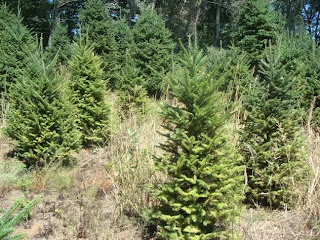A small field of trees in West Jefferson has what I think is Cryptomeria scale. I had samples sent to the Plant Disease and Insect Clinic in Raleigh to confirm it, but it definitely looks like the same thing we saw in Macon County earlier this summer.
There are several differences between Cryptomeria scale and elongate hemlock scale. First of all, there are more symptoms of yellow blotches on the needles. Most of the trees with Cryptomeria scale have these symptoms, whereas most trees with EHS have no yellow discoloration.
A close-up of the foliage shows the striking symptoms. Note how it is worse at the lower part of the shoot where more scales have settled.
The scales look quite different from EHS. The newest growth appears to have mostly nymphs or younger scales. They look almost like yellow dimples on the needles. They also reminded me of eggs cooked sunny side up with really big yolks!
Under the microscope you can see that even the young scales hide themselves under the cuticle on the needle, giving them protection, and making them harder to see. I guess that's what gives the appearance of a big yolk with a bit a white around it when seen through a hand lens. There are also some more mature scales in this shot at the top. They look bigger of course.
On the older growth, the scales seem to grow on top of each other. There are more mature scales. They look sort of round, and many look brownish, but those, I think have already died. The healthy scales are yellow when you look at them under the microscope.
Many of these scales have been fed on by the twice stabbed lady beetles. These were everywhere on the trees, just like they were in Macon County. They left holes in the scales.
The adult lady beetles feed on the scales as well as the larvae.
Here are some lady beetle larvae. There are so many larvae, they almost look like they are feeding on and damaging the trees. But they are feeding on the scales. However, there are so many scales, they don't destroy them all. I looked at some needles under the microscope where the lady beetles had obviously been feeding, and there were live scales with eggs still underneath dead scales which had been fed on.
Here are two adults with eggs and some crawlers. It was hard to get a good picture of the crawlers as they were moving around a lot. But basically, crawlers all look about alike.
A scale that hasn't yet produced eggs was flipped over for this photo. The thin coppery line going from the middle of the scale is the feeding tube. You can see it best against the green of the needle at the top and middle of the scale.
These trees really went down hill over the last month. The grower didn't notice anything wrong with his trees until recently. In fact they thought that it was worse today than it was just last week. And in reports from other states indicate that the scale builds up and spreads very quickly. Its also been very dry in Jefferson this summer which I'm sure helped the symptoms be worse.
These trees are in a residential area with houses all around. As with the other site in Macon County, the best explanation as to why Cryptomeria scale showed up is because someone purchased nursery plants from up north where this scale is much more common, and they moved into the Frasers. Cryptomeria scale feeds on many types of conifers, but it certainly seems to like Fraser fir.
The grower is going to spray these trees within a week with Dimethoate, Asana and Safari. Before spraying, they will cut out and destroy the worst trees. In fact, it would take at least a couple of years of good growth to cover up heavily damaged. trees. I thought it best to add the Safari on an experimental basis as research from other states indicates that Safari works well.
It's getting a bit late in the season to control these scales, but hopefully they will get some control. I'll assess them after a month to see how well the treatment worked and probably again in the spring. If need be, the grower plans to treat again in the spring.
Are there more sites with Cryptomeria scale in western North Carolina? It is certainly possible. Most growers now know what EHS looks like, but they could easily mistake this scale for EHS. It does look different, however. It is more rounded that elongated. There are also no white males, and no white waxy discoloration on the top of the needles. Another tell-tale sign are all the twice stabbed lady beetles which appear to be very characteristic of this scale.
This scale is much worse than EHS. It appears that it spreads faster, and it definitely has a greater effect on the tree. We have yet to see if it is just as hard or even harder to control. According to reports from Pennsylvania and Connecticut, control of both scales is similar.
If anyone thinks they have Cryptomeria scale, please let me know and I'll come out and look at it. Everyone needs to keep an eye out for this pest, so we can track if it is spreading.

















































